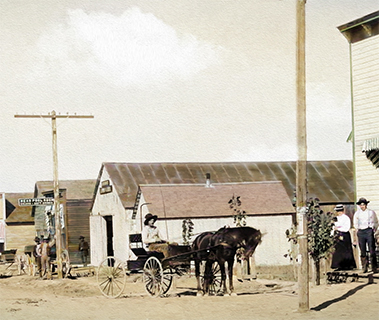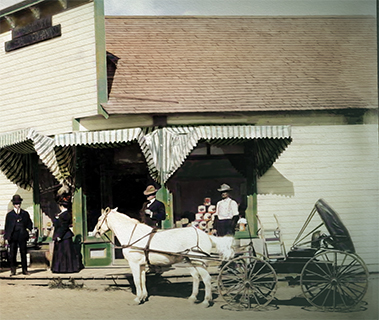





"I can remember the founding of the little town of Mead, Colorado in 1906, on one corner of the farm. The Great Western Sugar company was putting in a railroad for the transporting beets to the sugar mill, and had located a beet dump where the tracks cut across a corner of the farm. [. . .]. They wanted it to be a good town, with no "evil element," and had it stipulated in the titles to all of the lots that they sold, that liquor was not to be sold on any of the property, ever."
Remembrance of Things Past - by Myra Imogene (Mead) Cope. May 15, 1969.
December 4, 2022. Second Annual "Donuts with Santa"
For more information go here:
The Town of Mead has its roots in the last-minute decision of the Great Western Railroad to reroute its planned tracks and train station from Highlandlake to the eastern border of Paul Mead"s (nephew of Lorin C. Mead) farm, almost two miles away. Paul had donated a corner of his property for a "beet dump." A beet dump is where the farmers pile or "dump" their sugar beets until they can be taken by train to the beet processing factory. Sometimes the beets were dumped directly into the train cars using what was called a "highline beet dump. Other times if the factory wasn't ready for them yet, they were placed into a huge pile until the factory was ready for them.
Since the new beet dump was on the border of his land, Mead, Paul, at the advice of some business associates, and with help from his wife Ariet, laid out several blocks and streets including space for a park and school. He named the town Mead after his father, Dr. Martin Luther Mead, MD, the first resident doctor in the Highlandlake District. In December of 1905, he started offering building lots for sale. The first week alone he sold 35. By the time he finally filed the plat with Weld County on 19 February 1906, over 75 lots were sold.
The village continued to grow and in March of 1908, the residents agreed to charter the town, thus making Mead official.
At first, most stores and businesses were located on the east side of Old Main (Third) Street since that side of the road was not subject to the dry clause in the property deeds. These were mostly quickly thrown together wood-framed structures. Mead was finally chartered on March 17, 1908. Starting about 1910, Main Street moved to Fourth Street. Many of the new buildings were made of brick produced at the Mead brick yard . Some of these are still standing and in use today.
At its peak, Mead had a library, at least two doctors’ offices, one or more lawyers, several general stores, a hotel, grocery, meat market, two saloons, butcher shop, drug store, post office, lunchroom, pool hall, barber shop, two banks, newspaper, shooting gallery, and a bowling alley. Additionally, there were three filling stations, two auto garages, farm implement dealer, two livery stables, a lumberyard, three blacksmiths, harness repair shop, a brick yard, a car dealership, pickle factory, feed mill, and pea hulling factory.
In the 1930s, the Great Depression dealt a crushing blow to the town. For almost sixty years, the town struggled to overcome the depression’s debilitating effects until in the 1990s, families once again discovered Mead’s quaint charm and rural beauty. Today, Mead is a growing, vibrant, “Hidden gem of happy living”

Do you have papers, documents, photos, or any other items just taking up space? Don't sell or toss them! Donate them to us. We are building our archives, one piece of paper and artifact at a time.
For more information on donating your precious items, Contact Us Here.

With your generous donations we are able to continue our mission. You can donate in several ways:
Tap here for more information

Volunteering for our events and projects will go a long way toward giving back to our community and our wonderful history.
Watch here on our website and on social media for upcoming volunteer opportunities that you can take advantage. These may include volunteering in our office/research center, helping with events, becoming an reenactor, and fundraising.
For more information Tap Here: